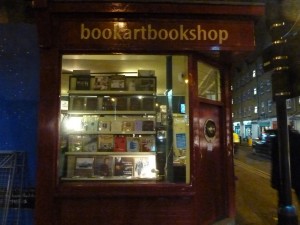 Last Christmas my mum bought me a Kindle. As a die-hard English Lit student, I ceremoniously threw it back at her across the sitting room, much to the alarm of my grandparents. I refused to betray the musty pages of hardbacks, the safe confines of the library; in retrospect, this was definitely a sign of final-year-induced Stockholm syndrome, whereby I had fallen in love with my captor: the book.
Last Christmas my mum bought me a Kindle. As a die-hard English Lit student, I ceremoniously threw it back at her across the sitting room, much to the alarm of my grandparents. I refused to betray the musty pages of hardbacks, the safe confines of the library; in retrospect, this was definitely a sign of final-year-induced Stockholm syndrome, whereby I had fallen in love with my captor: the book.
A year later, at a safe distance from the Modernist section of the library and with a more regular sleep pattern, I can see the appeal of the Kindle and, dare I admit, regret my violent rejection of it. Books are increasingly redundant, an anachronism which may soon be comparable to lugging scrolls or stone tablets around on the tube. A book is essentially a container for a text to be consumed by the reader.
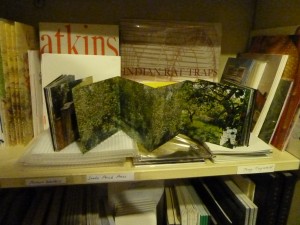 Bookart, however, posits the book itself as the primary experience of reading: the text is secondary. Avant-garde artists began interrogating the conceptual and material form of the book, partly as a strategy to bypass the hierarchy of the traditional gallery system. The aim being, that ideas could be disseminated in accessible, democratic forms available to people who might not otherwise enter art galleries. Bookart, or Artists Books, are works of art realized in bookform. If the text is transferred to a digital medium, the work loses its significance.
Bookart, however, posits the book itself as the primary experience of reading: the text is secondary. Avant-garde artists began interrogating the conceptual and material form of the book, partly as a strategy to bypass the hierarchy of the traditional gallery system. The aim being, that ideas could be disseminated in accessible, democratic forms available to people who might not otherwise enter art galleries. Bookart, or Artists Books, are works of art realized in bookform. If the text is transferred to a digital medium, the work loses its significance.
In other words, Bookart HAS to be experienced as a book. No Kindles allowed here!
Bookart theorist Johanna Drucker insists upon the ‘difficulty of trying to make a single, simple statement about what constitutes an artists’s book’, and excitedly questions the many different interpretations produced by this ambiguity:
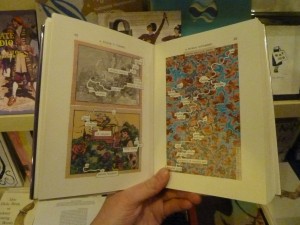 Is a book restricted to the codex form? Does it include scrolls? Tablets? Decks of cards? A block of wood with one end painted with a title, like a conventional spine? A walk-in space of oversized panels hinged together? A metaphysical concept, disembodied, but invoked in performance or ritual?
Is a book restricted to the codex form? Does it include scrolls? Tablets? Decks of cards? A block of wood with one end painted with a title, like a conventional spine? A walk-in space of oversized panels hinged together? A metaphysical concept, disembodied, but invoked in performance or ritual?
Luckily for us, this unique and innovative genre of art can be found, perused and purchased here in Shoreditch, at the little red bookshop just off Old Street: the Bookart Bookshop. I made a visit on a freezing Friday afternoon to investigate.
I was met with a treasure-trove of beautiful and innovative creations.
The first artist to catch my attention was Susan Johanknecht, lecturer at Camberwell Arts College. Her pieces include a small box to be opened, which is filled with cards of text and images reading ‘Who Will It Be’? Another piece by Johanknecht is a small black square that opens as a concertina of images, a popular technique in Bookart, gesturing at artisanal practices. Already, the bookshop was undermining my conventional expectations of what a book might be.
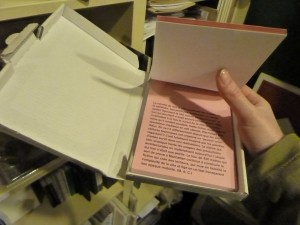 Another piece, by artist Uriel Orlow, is found in a cardboard box. Inside lies a small pink notebook with the title ‘What the Billboard Saw – La Ville Mode d’Emploi’. The excitement of experiencing these objects is not in reading them, but reveling in their material qualities: the tactile nature of the works and the childlike experience of opening them, unsure of what might be found inside.
Another piece, by artist Uriel Orlow, is found in a cardboard box. Inside lies a small pink notebook with the title ‘What the Billboard Saw – La Ville Mode d’Emploi’. The excitement of experiencing these objects is not in reading them, but reveling in their material qualities: the tactile nature of the works and the childlike experience of opening them, unsure of what might be found inside.
Another artist worthy of mention is John Bentley. His extensive selection of bookworks displayed in the shop includes a piece that catalogues paper debris found in Harrow, entitled Concerning the poetry of Lost Things. His works displays an interest in the poetics of place, with bookworks exploring Brixton, and other London boroughs.
Tom Philips work, A Humument, has become somewhat of a canonical work in the Bookart field. His book is a re-working of the Victorian novel A Human Document, in which he painstakingly illustrates each page, revealing only fragments of text in his intricate reworking of the found material.
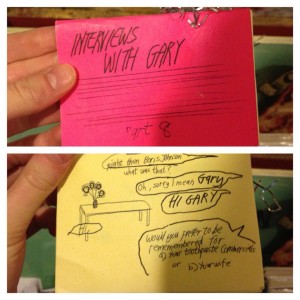 The bookshop houses bookart across the scale, ranging from more expensive, limited edition collectibles, to more inexpensive pieces designed to be produced in multiple copies, tapping into Drucker’s idea of the ‘democratic multiple’. The cheaper items are just as endearing and whimsical, including a £1 pamphlet entitled ‘I love you’ (a quirky potential V day present!) and a funny little piece called ‘Interviews with Gary’.
The bookshop houses bookart across the scale, ranging from more expensive, limited edition collectibles, to more inexpensive pieces designed to be produced in multiple copies, tapping into Drucker’s idea of the ‘democratic multiple’. The cheaper items are just as endearing and whimsical, including a £1 pamphlet entitled ‘I love you’ (a quirky potential V day present!) and a funny little piece called ‘Interviews with Gary’.
The Bookart Bookshop was founded by Tanya Peixoto in 2002, and she has done an inspirational job of bringing a specialist walk-in bookart bookshop into the heart of East London’s art world.
As well as a place to find, sell and buy books, the Bookart Bookshop also presents discussions, meetings, exhibitions, lectures, book launches and educational activities, all focusing on the never-ending debate surrounding bookart.
The bookshop presented me with an alternative concept of the book as an art object: not just a carrier of text. I can see the appeal of reading novels on a handy digital device, but these unique and beautiful creations reminded me of the enduring power of the book!
I definitely recommend a visit.
17 Pitfield St London, Greater London N1 6HB
020 7608 1333
http://www.bookartbookshop.com/




